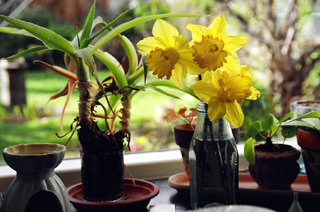Happy Birthday Zandara Kennedy
Extensively footnoted and balanced in its claims, John McNeill’s Something New Under the Sun is an engaging and worthwhile study of the environmental history of the twentieth century. It covers atmospheric, hydrospheric, and biospheric concerns – focusing on those human actions and technologies that have had the greatest impact on the world, particularly in terms of those parts of the world human beings rely upon. People concerned with the dynamic that exists between human beings and the natural world would do well to read this volume. As McNeill demonstrates with ample figures and examples, that impact has been dramatic, though not confined to the twentieth century. What has changed most is the rate of change, in almost all environmentally relevant areas.
The drama of some documented changes is incredible. McNeill describes the accidental near-elimination of the American chestnut, the phenomenal global success of rabbits, and the intentional elimination of 99.8% of the world’s blue whales in clear and well-attributed sections. From global atmospheric lead concentrations to the depletion of the Ogallala Aquifer, he also covers a number of huge changes that are not directly biological. I found his discussion of the human modification of the planet’s hydrological systems to be the most interesting, quite probably because it was the least familiar thing he discussed.
Also interesting to note is that, published in 2000, this book utterly dismisses nuclear power as a failed technology. In less than three pages it is cast aside as economically non-sensical (forever dependent on subsidies), inherently hazardous, and without compensating merit. Interesting how quickly things can change. The book looks far more to the past than to the future, making fewer bold predictions about the future consequences of human activity than many volumes of this sort do.
Maybe the greatest lesson of this book is that the old dichotomy between the ‘human’ and the ‘natural’ world is increasingly nonsensical. The construction of the Aswan High Dam has fundamentally altered the chemistry of the Mediterranean at the same time as new crops have altered insect population dynamics worldwide and human health initiatives have changed the biological tableau for bacteria and viruses. To see the human world as riding on top of the natural world, and able to extract some set ‘sustainable’ amount from it, may therefore be unjustified. One world, indeed.


please remove all associations between my real name and my livejournal username from all of your pages. this has gotten me into quite a bit of trouble. thank you.
Something of a challenge when I do not know who you are. I met dozens of people at that conference, at least a few of which have LiveJournals, none of which are mentioned in the entry above.
Sending me an email would probably be a much better way of dealing with this.
[Update: 1:14pm] I removed what was, in all probability, the link in question.
I recognize that photo from Lessia’s home. Yesterday on our return trip from Salt Spring Island, dad and I saw a large group of Orcas having a great time near Pender Island. It was amazing to watch their graceful beauty from the ferry.